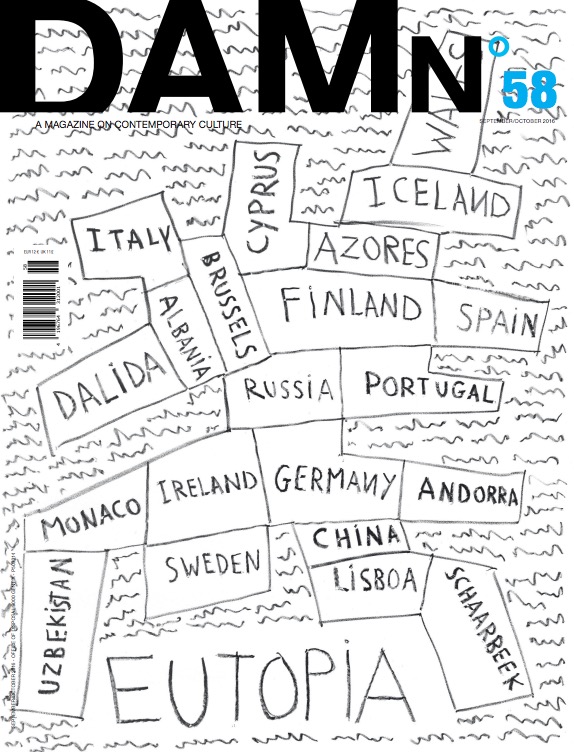All of Christo and Jeanne-Claude’s projects originate from their two hearts and heads. The pair has never accepted proposals or commissions because they have never fancied being contractors. Some of their projects have taken many years to realise due to the necessary permissions not being granted – for example, it took 32 years for Wrapped Trees, 26 years for The Gates, 25 years for the Wrapped Reichstag, 10 years for The Pont Neuf Wrapped, and 5 years for Running Fence. This latest project in Italy has taken a whopping 46 years to reach fruition, but happily, permission was not an issue. Once the site was chosen, every aspect of the project – in all its complexity – fell nicely into place.
As per the Iceberg Theory, when we look at a completed work of art, we see just the tip, and hopefully the successful end of a process, but what that pro- cess has actually entailed often remains unknown. Christo and Jeanne-Claude recently presented The Floating Piers at Lake Iseo in Italy. This summer, DAMN° met with tailor Ksenia Golub shortly after her return from the lake, where she helped configure three kilometres of orange fabric on top of the water. Later on, we had a long phone conversation with Christo himself, mainly about the two years of production that generated an ephemeral two-week (only) experience.
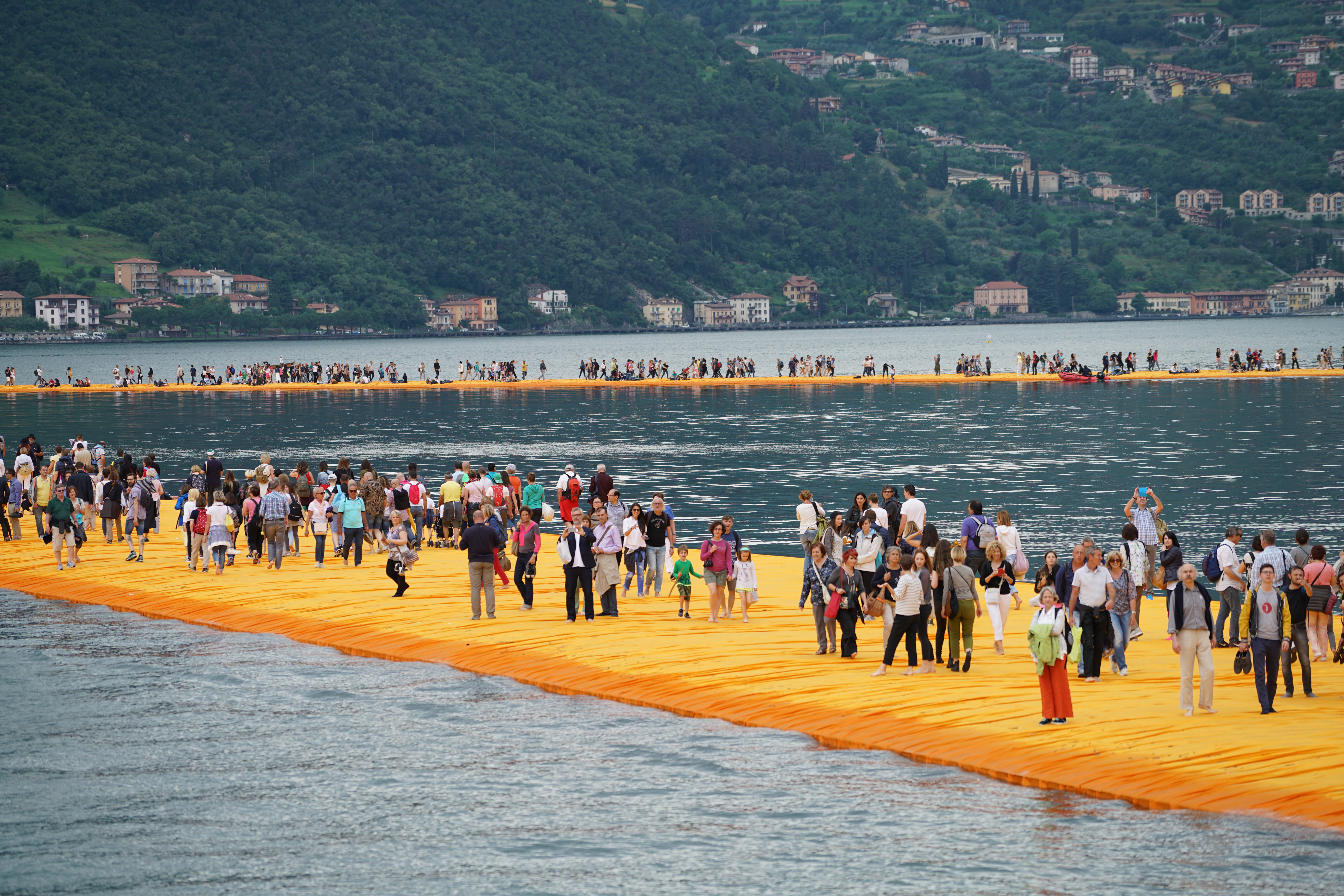 Visitors promenading on the floating piers...
Visitors promenading on the floating piers...
DAMN°: So, how did this project start?
Christo: Our idea to do floating piers came in 1970 but the site was only decided in 2014. A first pro- posal was to make the installation at Río de la Plata in Buenos Aires, but we were never granted permis- sion. In almost 50 years, Jean-Claude and myself have realised 22 projects and have succeeded to get permission for 37, from the mid-1960s until today. Some projects have been refused, others we didn’t want to do anymore, and some that were refused remained in our hearts and minds, as happened with this one.
DAMN°: Why Lago d’Iseo?
Christo: It’s the only saltwater lake in Europe that has a mountain as high as the Liberty Tower in Manhattan. These lakes are old glaciers so they are very deep; this one is 300-700 feet. It contains an island called Monte Isola where some 2,000 people live. There’s no bridge linking the island to the mainland so access is only by boat. This is why we chose Lake Iseo and Monte Isola, to connect them via floating piers so that people could walk to the island during those 16 days [18 June - 03 July]. And the piers also connect to the little island of San Paolo owned by the Beretta family [yes, that Beretta – the ‘first family of firearms’].
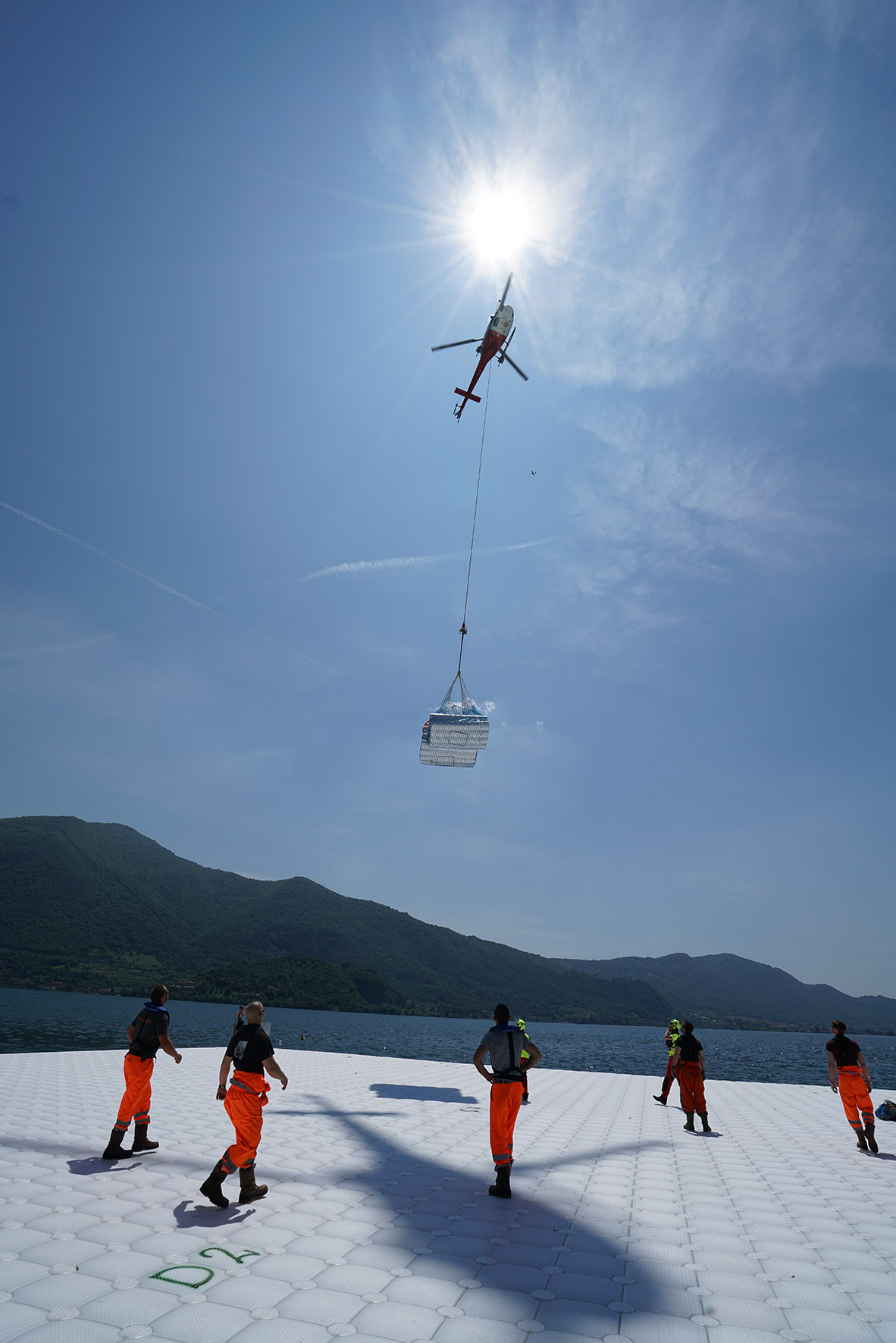 The white-felt-covered cubes that underlay the yellow fabric, with the fabric about to arrive, transported from Montecolino to San Paolo island by Elimast Helicopter Service, May 2016
The white-felt-covered cubes that underlay the yellow fabric, with the fabric about to arrive, transported from Montecolino to San Paolo island by Elimast Helicopter Service, May 2016
DAMN°: How do you go about organising such a large-scale installation?
Christo: Lots of art historians don’t understand that our projects have many similarities with architecture and urban planning. They are very complex to get permission for. We began working on site in October 2015 but the work started way before that.
Our projects always have two distinct parts, the software period and the hardware period. The software period is when we are not on site; it includes all of the engineering, my drawings, getting permissions, and many other things. And then there is the place where everything is brought together, the hardware period. Each of the projects also has a construction area; for this one, we rented Montecolino. There’s no factory or anything on that site, we used it only for organisation, installation, and removal, nothing was fabricated there.
 Workers putting carabiners through the grommets at the edge of the fabric, which then attach to a cable on the underside of the pier, 15 June 2016
Workers putting carabiners through the grommets at the edge of the fabric, which then attach to a cable on the underside of the pier, 15 June 2016
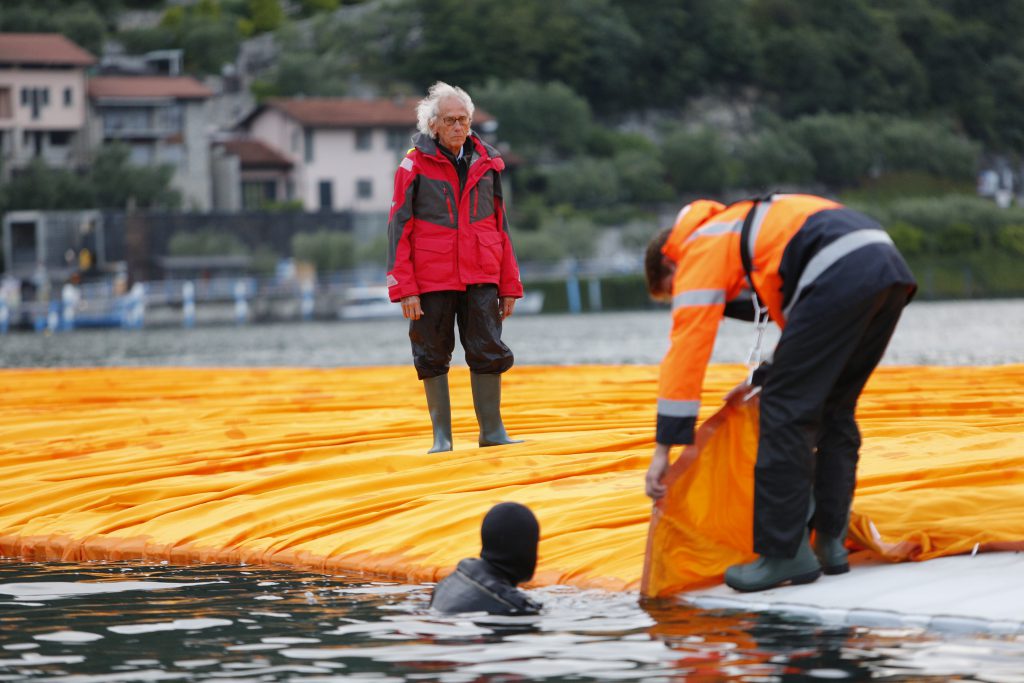 Christo watching a diver hook a fabric panel to the side of the floating pier, 15 June 2016
Christo watching a diver hook a fabric panel to the side of the floating pier, 15 June 2016
DAMN°: How did you obtain approval?
Christo: Getting approval is often is very difficult, but the government agency here was incredibly understanding. That was good luck. The President of the Lake Basin Authority was personally aware of our art and was sensitive to our request. Of course he is an educated man who had lived in the US, Vladimir Nabokov’s nephew, and he helped us move the project through the permit process.
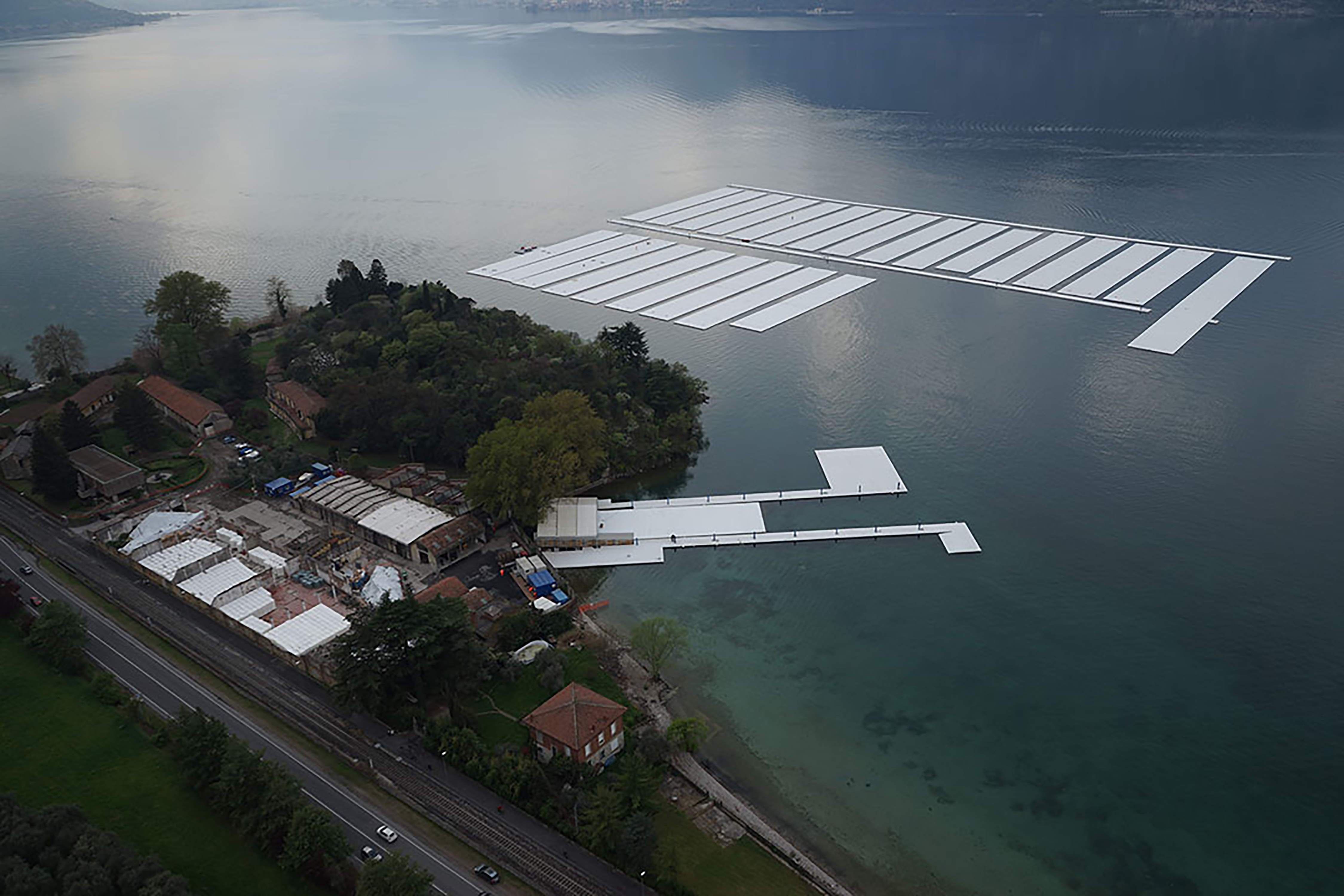 Aerial view of the building yard on the Montecolino peninsula, with the allocated parking area for the thirty 100 x 16 metre sections laid-out on the lake, April 2016
Aerial view of the building yard on the Montecolino peninsula, with the allocated parking area for the thirty 100 x 16 metre sections laid-out on the lake, April 2016
DAMN°: And what about the various phases of construction?
Christo: All of our projects are about things that have never been built before, so they require a team of chief engineers, construction directors, etc. Never before has three kilometres of floating pier without handrails been built. Try to find a bridge with no handrails where the water is 300 feet deep. That’s why you have to have many engineers working on the project. We had to fire some of them and find the right ones. This is the way with all our projects. We cannot decide how to do it in Manhattan, which is why there is always a secret place, somewhere to make a full-scale model – a small section of the project, in order to understand the physical structure, how it should be built.
Finding such a place is another story, because in getting permission for a life-sized mock-up in Italy everyone would know about the project, and we like to keep it very low profile. We finally found a small lake in Germany near the Danish border, in September 2014. After that we made another mock-up in the very stormy waters of the Black Sea in Bulgaria, near the Turkish coast, because of the strong winds. All these projects go through complex engineering and testing before the final design. At the very end, we need to hire a general contractor. We found a spectacular deep-water specialist from Bulgaria who built this entire project with a team of ocean workers he put together – from Bulgaria, Italy, France, ... professional workers. Naturally we had a huge number of unskilled workers as well, from all over Europe.
 One of many streets and squares covered with the orange fabric; photo: Ksenia Golub
One of many streets and squares covered with the orange fabric; photo: Ksenia Golub
DAMN°: How were the piers devised?
Christo: The piers were made of small, high-density polyethylene cubes, 50 x 50 by 40 cm. The process of fabricating them was very slow; it was a non-stop operation to make 220,000 cubes and 220,000 giant screws. These were assembled to create the sur- face of the long, 16-metre wide floating structure. Manufacture started in November 2014, using special moulds. The cubes were produced in a factory at the foot of the Alps, and because the process was so time-consuming we needed to make four moulds simultaneously. It was around the clock.
DAMN°: There also had to be anchors.
Christo: There are 190 anchors of 5.5 tonnes each in the bottom of the lake, placed there by divers using a special boat with a computer control room and enormous divers’ facilities. That entire installation was so complex, beginning in November-December 2015 and finishing in May 2016.
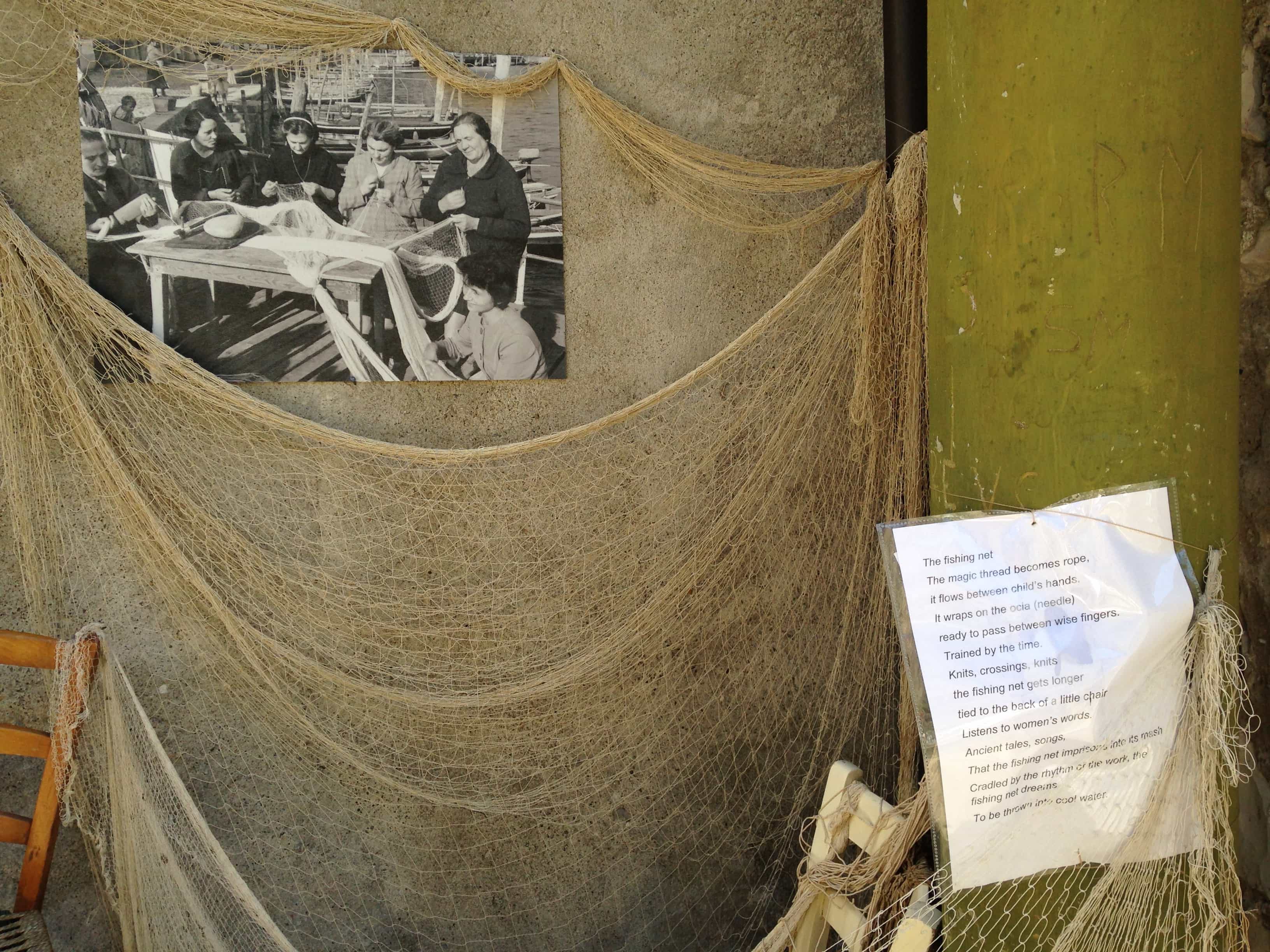 A historic photograph of a woman making fishing nets for the fishermen; photo: Ksenia Golub
A historic photograph of a woman making fishing nets for the fishermen; photo: Ksenia Golub
DAMN°: And then it was time for the fabric! Ksenia
Golub: It was impressive how everything was so well thought out. The fabric was thrown down in big bundles by helicopters at precise points, and then teams of about 10 people were formed to go to the different locations – you had to do this as fast as possible and there was a lot of area to cover. We were brought there by boat, along with sewing machines specially designed for this project. They were heavy to handle, weighing 7.5 kg each, keeping in mind that you had to support them on your body and it wasn’t solid ground. Standing in the water on this street of blocks covered in white felt, like a huge spine – it was completely overwhelming.
DAMN°: What were the most memorable mo- ments?
KG: A storm was forming, so we had to work fast. Sewing the fabric was uncomfortable because the winds were so strong that they lifted the whole plat- form up and down. At one point, everybody needed to be evacuated. I decided to stay, just watching the sky and the lightning. Finally, the Bulgarian team also stayed, as did a couple of German guys. It was incredible. We were near the Beretta residence, positioned slightly under the trees, waiting for the heavy rain to pass so that we could continue, because certain de- tails had to be finished in that area too, some even by hand. The opening was early the next early morning.
I had strapped the sewing machine across my shoulder and stood in position while the rest of the team opened the bag and rolled out the fabric. We then had to pull it, stretch it, and fold it in a particular way, all those layers of fabric. One person was behind, one was ahead, one was pulling, and then I started sewing. It wasn’t easy. But everybody was in it together, you had to become like one organism, and since it was quite an international team and my Italian is not great, it was all rather challenging. But then you would just say ‘ragazzi!’ with your eyes and indicate what you needed, and everything worked!
Written by Cristina Guadalupe Galván
Photos Wolfgang Volz, except where mentioned otherwise


